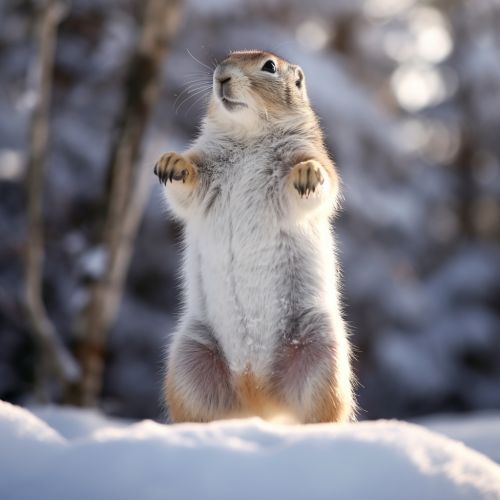Arctic Ground Squirrel
Taxonomy and Evolution
The Arctic Ground Squirrel (Spermophilus parryii) is a species of ground squirrel native to the Arctic regions. It is part of the genus Spermophilus, which includes several other ground squirrel species. The Arctic Ground Squirrel is the most northern of all the ground squirrels, and has adapted to survive in a harsh and unforgiving environment.


Description
Arctic Ground Squirrels are medium-sized rodents with sturdy bodies, short legs, and a moderately bushy tail. They have a body length of 39 to 40 cm, and a tail length of 10 to 12 cm. Their fur is thick and soft, providing insulation against the cold. The coloration varies from a light sandy color to a darker brown, with lighter underparts.
Distribution and Habitat
The Arctic Ground Squirrel is found across the Arctic regions of North America, from Alaska to Hudson Bay, and north to the Arctic Ocean. They inhabit a variety of habitats, including tundra, meadows, river valleys, and mountain slopes. They prefer open, well-drained areas where the soil is suitable for burrowing.
Behavior
Arctic Ground Squirrels are diurnal, meaning they are active during the day. They are social animals, living in colonies that can number in the hundreds. The squirrels communicate with each other using a variety of vocalizations, body postures, and tail movements.
Diet
The diet of the Arctic Ground Squirrel consists mainly of vegetation, including grasses, leaves, flowers, seeds, and berries. They also eat insects, eggs, and small vertebrates when available. They are known to cache food in their burrows for consumption during the winter.
Reproduction
Arctic Ground Squirrels mate in early spring, shortly after emerging from hibernation. The gestation period is about 25 days, and the female gives birth to a litter of 5 to 10 pups. The pups are born blind and hairless, but grow rapidly and are weaned at around six weeks of age.
Hibernation
One of the most notable aspects of the Arctic Ground Squirrel's life cycle is its long period of hibernation. In some areas, these squirrels hibernate for up to 8 months of the year, from late summer to the following spring. During hibernation, the squirrel's body temperature drops to just below freezing, the lowest known of any mammal.
Conservation Status
The Arctic Ground Squirrel is not currently considered to be at risk of extinction. However, like all wildlife, they face threats from habitat loss and climate change.
